Kate Lawrence's Blog, page 5
August 12, 2013
What Money Can’t Buy
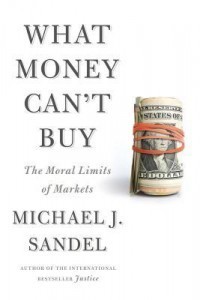 What Money Can’t Buy: The Moral Limits of Markets, by Michael J. Sandel. Farrar, Straus, and Giroux, 2012.
What Money Can’t Buy: The Moral Limits of Markets, by Michael J. Sandel. Farrar, Straus, and Giroux, 2012.
Anyone who is dismayed to see the unprecedented reach of advertising, corporate naming rights of public venues, and monetary payments for behavior formerly expected without incentives–like getting good grades or standing in line–will be glad to see an examination of how far markets should be allowed to penetrate our society. And those who haven’t noticed these things can use the book to catch up.
Sandel, a Harvard professor of government, doesn’t strive to make a particular case, however. In this the book was different from most I read about social issues, in which the author is trying to persuade the reader to a certain viewpoint. Instead, Sandel just wants the reader to take a close look at how much of our social commons is now for sale, and to reflect about whether benefits outweigh losses. The book is helpful, and the fact that he wrote it and teaches courses about the subject demonstrates his concern, but I would have welcomed a little more passion.
July 30, 2013
When Everything Changed
 When Everything Changed: The Amazing Journey of American Women from 1960 to the Present, by Gail Collins. Little, Brown, 2009.
When Everything Changed: The Amazing Journey of American Women from 1960 to the Present, by Gail Collins. Little, Brown, 2009.
Older women will recall much of the material covered, younger women may be reading it for the first time, but all ages will be amazed at how sexist our society was! Rather than just a compilation of facts, this history is told largely in the words of women who lived it, obtained by the author through dozens of interviews.
Although our society is not at perfect equality yet by any means, change has happened surprisingly quickly, considering that women have been oppressed for millennia. We women are fortunate to be living at the present time, able to leave behind so many of the restrictions our sisters faced in the past, even the recent past.
July 5, 2013
My Beef with Meat
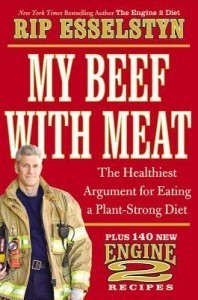 My Beef with Meat: The Healthiest Argument for Eating a Plant-Strong Diet–Plus 140 New Engine 2 Recipes, by Rip Esselstyn. Grand Central Life & Style, 2013.
My Beef with Meat: The Healthiest Argument for Eating a Plant-Strong Diet–Plus 140 New Engine 2 Recipes, by Rip Esselstyn. Grand Central Life & Style, 2013.
Rip Esselstyn’s second book–following The Engine 2 Diet–is clear, concise, down-to-earth, at times humorous, and will surely answer most questions people have about why we should be eating whole plants instead of animal products and processed food. This is a quick, go-to guide for such topics as protein, calcium, iron, what’s wrong with paleo, why grass-fed is no better than grain-fed, why oils should be avoided, and numerous other topics. Although mostly about health, the book also comments on animal suffering and the environment. And the recipe section!! I can hardly wait to try some of them. I was fortunate to hear the author live earlier this month at a local bookstore, and was impressed with his command of issues and facts, his friendly style, and the enthusiasm he conveyed. He’s an excellent ambassador for a healthier America.
June 19, 2013
The Green Boat
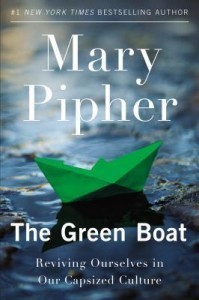 The Green Boat: Reviving Ourselves in Our Capsized Culture, by Mary Pipher. Riverhead Books, 2013.
The Green Boat: Reviving Ourselves in Our Capsized Culture, by Mary Pipher. Riverhead Books, 2013.
For anyone struggling to stay hopeful in a society in which corporate power rules and serious action on climate change by our government has not even begun, this timely little book provides strong support. As in her previous books, Mary Pipher writes simply, powerfully, humbly, and with a great heart. Instead of giving some intellectual treatise about how to sustain hope, she movingly describes her own experience, along with similarly motivated friends, in opposing the Keystone XL pipeline in her home state of Nebraska (which is on the proposed route of the pipeline).
Pipher’s group faced stiff and well-funded opposition, not just from TransCanada, the pipeline’s builder, but also from the Nebraska governor and legislators, who sided with TransCanada. Pipher and her coalition in Lincoln starting meeting regularly for potlucks and discussion, became friends, began to plan fun and creative public events and other actions to bring attention to the issue, were sometimes successful, sometimes discouraged, but most importantly, didn’t give up despite setbacks. (The ultimate outcome is still uncertain.) She saw firsthand that feelings of frustration and isolation are greatly relieved by taking action on behalf of a passionately-held cause, and that in so doing, a community develops. Ultimately hope is not some elusive feeling we may try to talk ourselves into, but is actively generated by a community that keeps showing up to defend the planet and its living beings. The greater the number of small groups of committed folks there are, the more hope is created, both for those involved and for the larger society.
The Green Boat covers some of the same ground as Joanna Macy’s excellent Active Hope, but if you only have time to read one, read Pipher.
May 10, 2013
Green Book Awards Announced
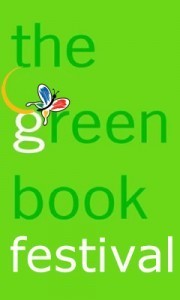 Organizers of the Green Book Festival, to be held later this month in San Francisco, have announced the winners of book awards in over a dozen categories.* I learned of this because a book to which I contributed a chapter was the winner of the Business category. The book, Greening Libraries, published by Library Juice Press in 2012, showcases librarians who have pioneered ways to educate their patrons about environmental and sustainability issues.
Organizers of the Green Book Festival, to be held later this month in San Francisco, have announced the winners of book awards in over a dozen categories.* I learned of this because a book to which I contributed a chapter was the winner of the Business category. The book, Greening Libraries, published by Library Juice Press in 2012, showcases librarians who have pioneered ways to educate their patrons about environmental and sustainability issues.
My chapter, “Library-Sponsored Sustainable Living Outreach in Denver,” describes programs I and a few other librarians working for the Denver Public Library have implemented toward that goal. [I am now retired, but worked as a DPL librarian for 14 years.] These programs included successfully urging a large library fundraising event to “go green” with recyclable table service, locally produced foods, and website information about libraries’ environmentally beneficial aspects. We created “infomarks” (like bookmarks, but including DVDs and other media) that listed available resources the library offered on topics like global warming and peak oil, local and sustainable food, gardening, efficient transportation, and energy conservation. We put up displays in the central library on similar themes, while informing the public about local environmental organizations. We offered bicycle maintenance workshops, and hosted author David Korten to lead a community conversation on “What Does a Healthy Economy Look Like and How Do We Get There From Here?” And much more.
These were the highlights of the chapter I wrote about local Denver efforts, but the book is national in scope. Librarians across the country describe what they are doing through their library systems to build support for a wide variety of green actions in their communities. Glancing through it is encouraging: lots of talented people are working to transform public awareness on issues of critical importance to our collective future.
*One of the awards went to a book on veganism and the environment: Comfortably Unaware by Dr. Richard Oppenlander.
April 23, 2013
The Ethics of What We Eat
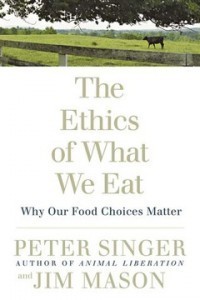 The Ethics of What We Eat: Why Our Food Choices Matter, by Peter Singer and Jim Mason. Rodale, 2006.
The Ethics of What We Eat: Why Our Food Choices Matter, by Peter Singer and Jim Mason. Rodale, 2006.
At least three times a day, we all make choices that have profound ethical consequences: what we eat. After interviewing three actual families about the foods they choose and why, authors Singer and Mason track down producers of these commonly-eaten foods and examine the means of production. Noting that “no other human activity has had as great an impact on our planet as agriculture,” they show how animals, our land, and oceans are treated in that process. The book is not a vegetarian polemic, although both authors are vegetarians. Rather it provides a balanced investigation of hidden factors in food production, and asks readers to make the kindest choices they possibly can. It is, however, strong in its condemnation of factory-farmed meat, eggs, and dairy products: “Since factory farming inflicts a vast quantity of unjustifiable suffering on animals, persuading others to boycott it should be a high priority of anyone concerned about animals.”
For most people, transitioning away from meat is best done gradually, and the focus need not be on perfection. The authors write, “Personal purity isn’t really the issue. Not supporting animal abuse–and persuading others not to support it–is.” If one still wants to eat meat on some occasions–at family gatherings, business lunches, and when traveling, for example–one can still reduce or eliminate meat consumption at other times. To help readers locate acceptable food sources, the book includes a “Where to Find Ethical Food” chapter at the end. The take-away: Get informed, decide what ethical eating would look like in your life, and then do something.
Singer’s books never disappoint; he thinks clearly, is thorough, presents convincing research, and conveys compassion for all beings. I may sometimes disagree with him, but am better informed for having heard him out.
April 12, 2013
Gift from the Sea
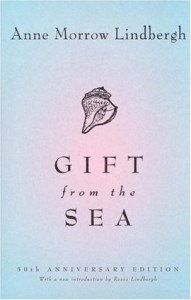 Gift from the Sea, by Anne Morrow Lindbergh. Random House, 1955.
Gift from the Sea, by Anne Morrow Lindbergh. Random House, 1955.
This heartfelt little book was a big bestseller when it was published in 1955 and still resonates today. Who doesn’t need a reminder of the sanity of simple living and occasional solitude? She writes: “We seem so frightened today of being alone that we never let it happen. Even if family, friends, and movies should fail, there is still the radio or television to fill up the void … Even day-dreaming was more creative than this; it demanded something from oneself and it fed the inner life . . . We choke the space with continuous music, chatter, and companionship to which we do not even listen.” In these days of Facebook, Twitter, and other means of constant connectivity which Lindbergh could not have imagined, her words mean even more. And this: “Modern communication loads us with more problems than the human frame can carry.”
She also has thoughtful insights on accepting change, and on women emerging from what we look back on as a very sexist time period.
February 23, 2013
Twenty-Five Years A Vegan
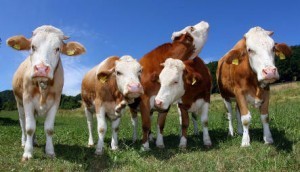 This month I observed the 25th anniversary of the date I committed to be a vegan– to do the best I possibly could not to eat, wear, or use anything from an animal. Using the ballpark figure of 95 animals saved per year by each vegan–and it may be higher–I’ve saved 2,375 animals just by choosing different foods. I’ve also substantially cut my contribution to environmental degradation, and improved my health. Pretty impressive results for just picking up the bean burrito instead of the beef, choosing a tofu add-on instead of chicken, saying, “can I get that without cheese?”, “no butter on the popcorn, please” and similar minor actions.
This month I observed the 25th anniversary of the date I committed to be a vegan– to do the best I possibly could not to eat, wear, or use anything from an animal. Using the ballpark figure of 95 animals saved per year by each vegan–and it may be higher–I’ve saved 2,375 animals just by choosing different foods. I’ve also substantially cut my contribution to environmental degradation, and improved my health. Pretty impressive results for just picking up the bean burrito instead of the beef, choosing a tofu add-on instead of chicken, saying, “can I get that without cheese?”, “no butter on the popcorn, please” and similar minor actions.
In terms of learning to accommodate to the alternative foods and other products necessary to keep the commitment, the most difficult aspect for me was not food but shoes. I need a narrow-width shoe, which was no problem when I was wearing leather, but the synthetic and canvas alternatives do not come in narrow sizes. This is still true today after all these years. My best effort was to buy medium width in styles that have a strap or laces across the arch, so that I could get them as tight as possible. Still they did not fit properly, and my feet finally rebelled after 20 years of this with an episode of plantar fasciitis. This painful condition, primarily affecting runners and overweight people, can also strike those who wear ill-fitting shoes, as it did me. I’ve solved the problem by wearing narrow-width running shoes, synthetic of course, all the time, giving up on style for the sake of arch support and comfort, and I’m fine now. I can proudly say that despite my craving for stylish, properly- fitting leather shoes, I never gave in, never wore or used leather.
Then there’s the social aspect of veganism, the countless awkward moments my diet caused me over the years with family, friends, co-workers, spiritual communities, and other social groups. When I look back, I am frankly amazed that my empathy with animals was sufficiently strong to stick with the vegan commitment through all those times of social isolation. So many birthday cakes I was unable to share (I always had a vegan cake for my own birthday, of course). Two incidents particularly stick in my mind. One was a wedding rehearsal dinner. I tried twice to find out where the dinner was going to be held so that I could contact the restaurant in advance, but the bridal couple did not decide until the day of. It was a steak house, very busy that night, which was unable to provide a vegan entree. My husband and I ended up eating a side salad and baked potato while everyone else had a full meal with dessert. The other incident was at work. My boss was aware I usually could not share in office treats–except the ones I provided myself–so one day she brought to an office party a dessert she made herself, saying, “This has no eggs or dairy products, so we can all enjoy this.” I was so pleased, ready to take a serving, when I discovered it contained marshmallows! Not only was it not vegan, it wasn’t even vegetarian! I was able to delay by eating some chips, etc. and then she was called away; she never knew I didn’t eat her dish. (This was long before the availability of vegan marshmallows.)
Does this mean I think veganism is not worth the trouble? Not at all!! I would not have done anything differently. To prevent the unspeakable suffering of those thousands of animals I would otherwise have eaten or worn is absolutely worth any discomfort on my part. Throughout these 25 years I have had other vegans to socialize with, and fortunately vegan food tastes great! Now that veganism appears to be catching on, I expect the social isolation will decrease, and I rejoice that more and more people are seeing veganism’s profound benefits to all beings.
January 29, 2013
Caregiving 101
I was involuntarily enrolled in an ongoing personal Caregiving 101 course last December 5 when my husband Keith Akers suffered a cerebral hemorrhage. I, as well as everyone else who knows him, was shocked that a fit, trim, long-term vegan with ideal blood pressure numbers would find himself in this situation. Doctors confirmed he had no aneurysm, no torn artery, no clots, no atherosclerosis; apparently a small capillary or vein burst. After nine days in the hospital–the first five in Critical Care–he came home, temporarily unable to walk unaided or dress himself.
We are extremely fortunate that he has no permanent damage or loss of function. However, any bleeding in the brain is life-threatening and the healing process can be lengthy. Now eight weeks later, he is mostly back to normal except he still has headaches and tires easily. He has not yet resumed socializing, as he finds that to be the most tiring activity of all.
After the time in the hospital, stressful and at times frightening to us both, he came home and the caregiving experience began in earnest for me–my first time to be in such a situation. I’d expected I’d be adding to my usual tasks everything necessary for his care, but what I hadn’t realized is that the caregiver also takes on all the chores that the sick person had been doing. In our case that meant all the laundry, the other half of the housework and cooking, and many errands. Suddenly I was overwhelmed.
Although not nearly so painful and disorienting as what the sick person faces, the caregiver too has a recovery period. Positive aspects are that facing the possible loss of a loved one illuminates clearly how precious they are, plus it slows down the pace of life and opens the heart. In addition, the stress must be released and normalcy re-encountered from a somewhat different viewpoint. I’m working on it.
November 15, 2012
Chasing Ice–a must see!
 I had the opportunity to attend a pre-release screening of a new documentary, Chasing Ice. The title might sound like another travel/adventure film, and it is, but much more. It may finally take us to the tipping point in convincing the general public that climate change is real and that we must not delay in addressing it.
I had the opportunity to attend a pre-release screening of a new documentary, Chasing Ice. The title might sound like another travel/adventure film, and it is, but much more. It may finally take us to the tipping point in convincing the general public that climate change is real and that we must not delay in addressing it.
Environmental photographer James Balog and his crew placed cameras at a couple of dozen places in the Arctic to take time-lapse photos of glaciers over a period of several years. The results are startling and undeniable: glaciers are melting at an unprecedented and astonishing rate. Such indisputable visual evidence, obtained at great expense and under difficult conditions, reaches viewers in a much more dramatic way than previous films like An Inconvenient Truth. We follow the crew as they penetrate remote and highly inhospitable locations to place the cameras and later to retrieve the images. We gain a sense of Balog’s determination to produce the evidence that will stimulate a mass movement to take action. The livability of our planet is at stake, and time is critical.
Find out more, watch the trailer, and check showtimes here. In the Denver area, see it at Chez Artiste Nov. 23 – 29.



